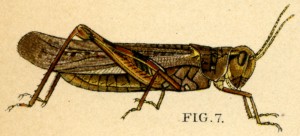by Jack El-Hai, Wonders & Marvels contributor
In the second week of June 1873, a southwest wind carried a strange brown cloud over the border from Dakota Territory into Minnesota. Pioneer families initially mistook the cloud for a rain or dust storm. But as it filled the sky, they could see that it contained millions of tiny animated specks.
The cloud obscured the sun, and suddenly an agrarian nightmare became real. Hordes of winged insects descended upon the fields, devouring virtually all crops and green plants.
Though commonly called grasshoppers, these fiercely hungry insects were Rocky Mountain locusts. They battled humans for control over the American Midwest during the mid-1870s. For five consecutive summers the locusts ravaged farmland, honeycombed the soil with eggs, and forced bewildered state governments to enact drastic and unprecedented measures. Then, even more mysteriously than they had appeared, the locusts vanished.
The Rocky Mountain locust normally lived in the eastern foothills of the Rockies, from Colorado to Canada. Periodic population explosions drove large numbers to seek food beyond their native range, and they took to the winds. Crossing the plains at speeds approaching 70 miles per hour, they reached Minnesota in the summer of 1873 eager to feast and breed.
And they reproduced prolifically, lacing the soil with pods containing up to 28 eggs each. During the next two years, the eggs hatched and the cycle continued. The year 1876 brought the most overwhelming attack of locusts in the recorded history of the Upper Midwest. That year the locusts were particularly voracious and aggressive. When feasting in a field, as a pioneer woman wrote, “the sound of their feeding could be heard yards away. Seldom did they leave a field until every stalk, leaf, and green head was consumed.” Throughout Minnesota, 28 counties reported serious damage.
A new governor, John Pillsbury, toured the state incognito to view the devastation first-hand. He was appalled. The insect invasion destroyed Minnesota’s wheat crop that summer, with only half of the previous year’s total harvested. More than a fifth of the state’s oats and corn went to the locusts, as well.
Desperate farmers tried their luck with the new products of inspired inventors. The Simpson Locust Crusher, a wooden contraption dragged by horses, scooped up and pulverized the insects. The Adams Locust Pan drowned them in oil. The Hopperdozer trapped them on metal sheets coated with coal tar or molasses. Governor Pillsbury also urged farmers to fight the locusts with “loud and discordant noises made by striking tin vessels, and by shrieking and yelling with the voice.”
By summer’s end, the locusts embedded their eggs into the earth of 42 Minnesota counties covering an enormous area. One farmer reckoned that his fields contained 150 eggs per square inch, or “the nice little pile of 6,586,272,000 on seven acres of my farm.” The signs pointed toward another ruinous year in 1877, which would sink the state’s economy. For the forthcoming growing season, the state legislature passed a law requiring all men between 21 and 60 to donate a day per week for five weeks for the collection and destruction of locusts and eggs.
Pillsbury, however, dealt with the threat of crisis in his own fashion. He declared April 26, 1877, a day of statewide prayer and fasting to invoke God’s prevention of the coming disaster. Although religious skeptics protested the governor’s faith in prayer, Pillsbury thought he had proved the skeptics wrong. “The very next night,” he later remembered, “it turned cold and froze every grasshopper in the state stiff — froze them solid.” His recollection was inaccurate. Though retarded by a late frost, the insects did hatch and damaged many sections of western Minnesota. But for unknown reasons the locusts took flight and vanished in July, without depositing any eggs. The bumper wheat crop of 1877 was the best in the state’s history.
One swarm of locusts did return to Otter Tail County, Minnesota, in 1888, and some insects appeared in North Dakota in 1900. The last was spotted in 1902 in Manitoba. After that, the Rocky Mountain locust never again bugged Minnesotans or anyone else. The species is now extinct.
Note: I previously wrote about the locust plague in May 1986 for Mpls.St.Paul magazine.
Further reading
Lockwood, Jeffrey A. Locust: The Devastating Rise and Mysterious Disappearance of the Insect That Shaped the American Frontier. Basic Books, 2009.
Yoon, Carol Kaesuk. “Looking Back at the Days of the Locust.” The New York Times, April 23, 2002.

